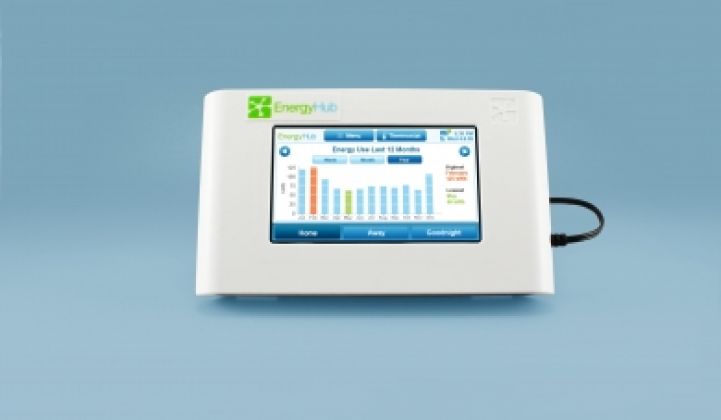EnergyHub is a 25-employee, VC-funded smart grid startup with offices near Brooklyn's scenic Gowanus canal, "the only body of water in the world that is 90 percent guns." (That quote is from Jonathan Lethem's book, Motherless Brooklyn.)
EnergyHub's home energy networking products aim to give the residential energy consumer control and insight into their energy usage. That's the high-level aim. The actual implementation of that comes in the form of a touchscreen dashboard that is wirelessly connected to a thermostat replacement, mesh-networked plugs and electrical strips along with a wireless controller and internet interface.
EnergyHub designs the hardware and writes the software for the product suite. These products need to be easy to operate and offer maximum consumer friendliness or face a very short "mean time to kitchen drawer." To prevent that from happening, the product line from EnergyHub needs to be a "seamless, consumer-friendly chain of products that work just right," and an "ecosystem that works harmoniously," according to EnergyHub CEO Seth Frader-Thompson, who comes to the home energy usage market through a circuitous career path of robotics, laser vision and MEMS.
He calls this undertaking a "totally different realm of customer expectation."
There are a number of firms pursuing the home energy market, including Tendril, Onzo, AlertMe, PassivSystems, Control4 and EcoFactor. However, when it comes to credible companies, the CEO said, "I'd be hard pressed to name five companies in the space."
And obviously only a few of those home energy controller aspirants are going to survive.
There are two routes to market in this field. The first is through the utility and working in concert with a smart meter. Utilities anticipate rolling out a subsidized version of this type of product suite to around 25 percent of their customers. This 25 percent comprises those in low-income programs, those with exceptionally high usage and those who sign up for demand response or load control programs. In the U.S., this represents a market of about 40 million households.
The second route to market these companies are pursuing is to reach out directly to consumers through a retail channel and provide a solution in the $100-to-$300 price range. This type of system can help households achieve a 15 percent to 20 percent savings on their electric bill -- so, a consumer with a monthly bill of $100 would save between $180 to $240 a year on their electric bill.
EnergyHub is currently working the utility route and is deployed in the field with "purchase orders and real contracts" from at least eight utilities and is working with many more. New York's Consolidated Edison is one of them.
The CEO acknowledges that this business model is more a channel play and execution play than a technology play, and that there are conflicting and not always obvious sets of motivations for adopting this technology. Frader-Thompson explains, "The utility's motivation is demand response and avoiding the cost of adding capacity, energy efficiency -- but sometimes it's just to please the regulators."
The consumer's motivation is also complicated. Is saving $10 to $20 a month enough for the American consumer to make this behavioral change? Consumers are vexing entities and don't always respond to the straight business case. However, with oil spills and global warming in the headlines, consumers might respond to incentives other than filthy lucre. We've already asked, "Does the residential smart grid have a killer app?"
In any case, "You need to be better than a one-year ROI if the consumer is paying for it," according to Frader-Thompson.
EnergyHub and the other home energy dashboard firms need to get beyond the range of $15-per-month savings, educate the customer and convey the true value to the consumer to make these products into must-have devices akin to iPads. Think iPlugs and iThermostats.



